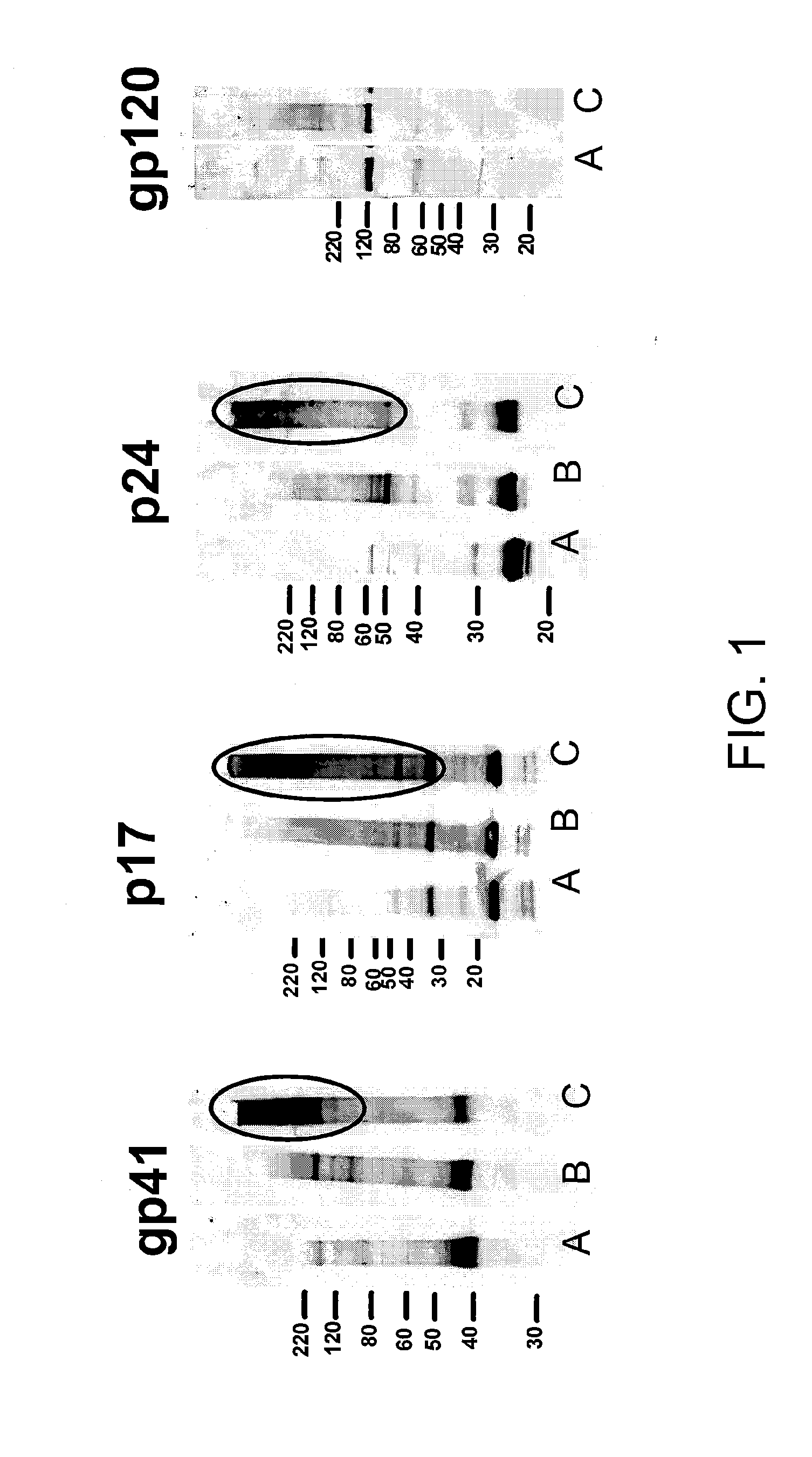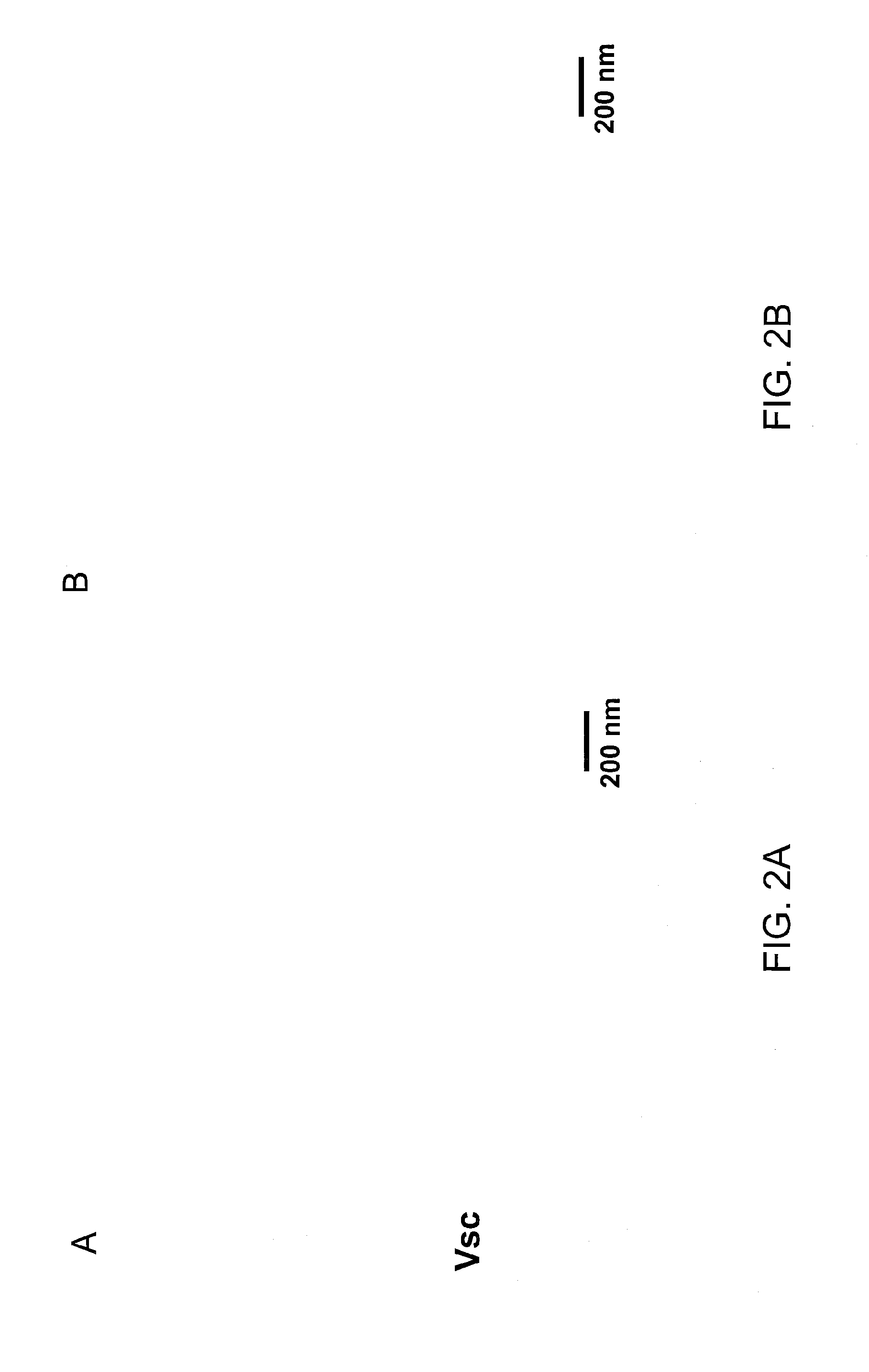Cellular And Viral Inactivation
a virus and inactivation technology, applied in the field of viruses inactivation, can solve problems such as particularly difficult choi
- Summary
- Abstract
- Description
- Claims
- Application Information
AI Technical Summary
Problems solved by technology
Method used
Image
Examples
example 1
Crosslinking Viral Membrane Proteins with 1,5-Diazidonaphthalene
[0127]This Example shows that 1,5-diazidonaphthalene (DAN) crosslinks transmembrane and capsid proteins in HIV-1 and that viral structures are not compromised after such crosslinking.
Methods
Viruses
[0128]HIV-1 (MN) / H9 clone 4 (lot #P3592 and lot #P3602; provided by the AIDS Vaccine Program) was propagated in H9 cells, as described previously (Ott at al. 1995). Concentrated virus preparations were produced by sucrose gradient banding in a continuous-flow centrifuge (Bess at al. 1997).
Treatment with Hydrophobic Crosslinkers
[0129]HIV-1MN viruses were suspended in Phosphate Buffered saline (PBS) at a concentration of 0.5-1.0 mg / ml. A stock solution of 8.0-8.69 mM crosslinkers (e.g., DAN) in DMSO was prepared. The crosslinker solution was added to the viral suspension under dim light to a final concentration of 100 μM. The suspension was then irradiated at a wavelength of 300 nm (or higher) using an ozone free 100 W mercury a...
example 2
Detergent-Inactivation of Viruses
[0136]This Example shows that 1,5-diazidonaphthalene (DAN) crosslinks transmembrane and capsid proteins in HIV-1 and that viral structures are not compromised after such crosslinking.
Methods
[0137]HIV-1 MN virions were treated with 100 μM of 1,5-diazidonaphthalene (DAN) and then irradiated with UV light for 15 minutes to crosslink viral membrane proteins as described in Example 1. After crosslinking, the virions were treated with 1% Triton X100 at 37° C. for 1 hour. As a control, HIV virions were subjected to the same detergent treatment but with no DAN crosslinking. Both control and test viral particles were separated from the detergent and other impurities by centrifugation in an Optima TLX Ultracentrifuge (TLA 120.1 rotor) using a 23% sucrose cushion at 45,000 rpm for 35 minutes. The pellet containing viral particles was isolated. Recovery of viral particles was evaluated by measuring the amount of the transmembrane protein gp41 present in the pell...
example 3
INA (1-azido-5-iodonaphthalene) as a Crosslinker
[0139]This Example illustrates that INA (1-azido-5-iodonaphthalene) is an effective crosslinking agent for viral inactivation when INA is used with ultraviolet irradiation.
Methods
[0140]To test the effectiveness of INA, 100 uM of either DAN, or INA, or DMSO (control) was combined with HIV virions (0.5 mg / mL) and the mixture was exposed to UV irradiation (while no UV filter was used, the wavelength greater than 280 or greater than 330 nm) for 15 minutes. The structures of DAN and INA are shown below.
[0141]A portion of the mixture was then electrophoretically separated and a western blot was prepared. The blot was stained for the transmembrane protein in HIV (41).
Results
[0142]As shown in FIG. 6 bands are present in the INA treated HIV sample (lane 1) that have higher molecular weights than those observed for uncrosslinked HIV (lane 4). These data demonstrate that INA is an excellent crosslinking agent for viral proteins when used on live ...
PUM
| Property | Measurement | Unit |
|---|---|---|
| hydrophobic | aaaaa | aaaaa |
| composition | aaaaa | aaaaa |
| structure | aaaaa | aaaaa |
Abstract
Description
Claims
Application Information
 Login to View More
Login to View More - R&D
- Intellectual Property
- Life Sciences
- Materials
- Tech Scout
- Unparalleled Data Quality
- Higher Quality Content
- 60% Fewer Hallucinations
Browse by: Latest US Patents, China's latest patents, Technical Efficacy Thesaurus, Application Domain, Technology Topic, Popular Technical Reports.
© 2025 PatSnap. All rights reserved.Legal|Privacy policy|Modern Slavery Act Transparency Statement|Sitemap|About US| Contact US: help@patsnap.com



